Published on
Last updated on
Pie Crust
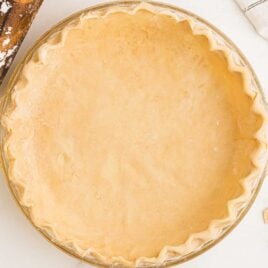
Every pie is better with a homemade pie crust, and nothing beats that flaky, pastry dough perfection. This pie crust recipe is simple and easy to make, but in the end, it will have you feeling fancy with your picture-perfect pretty pie.
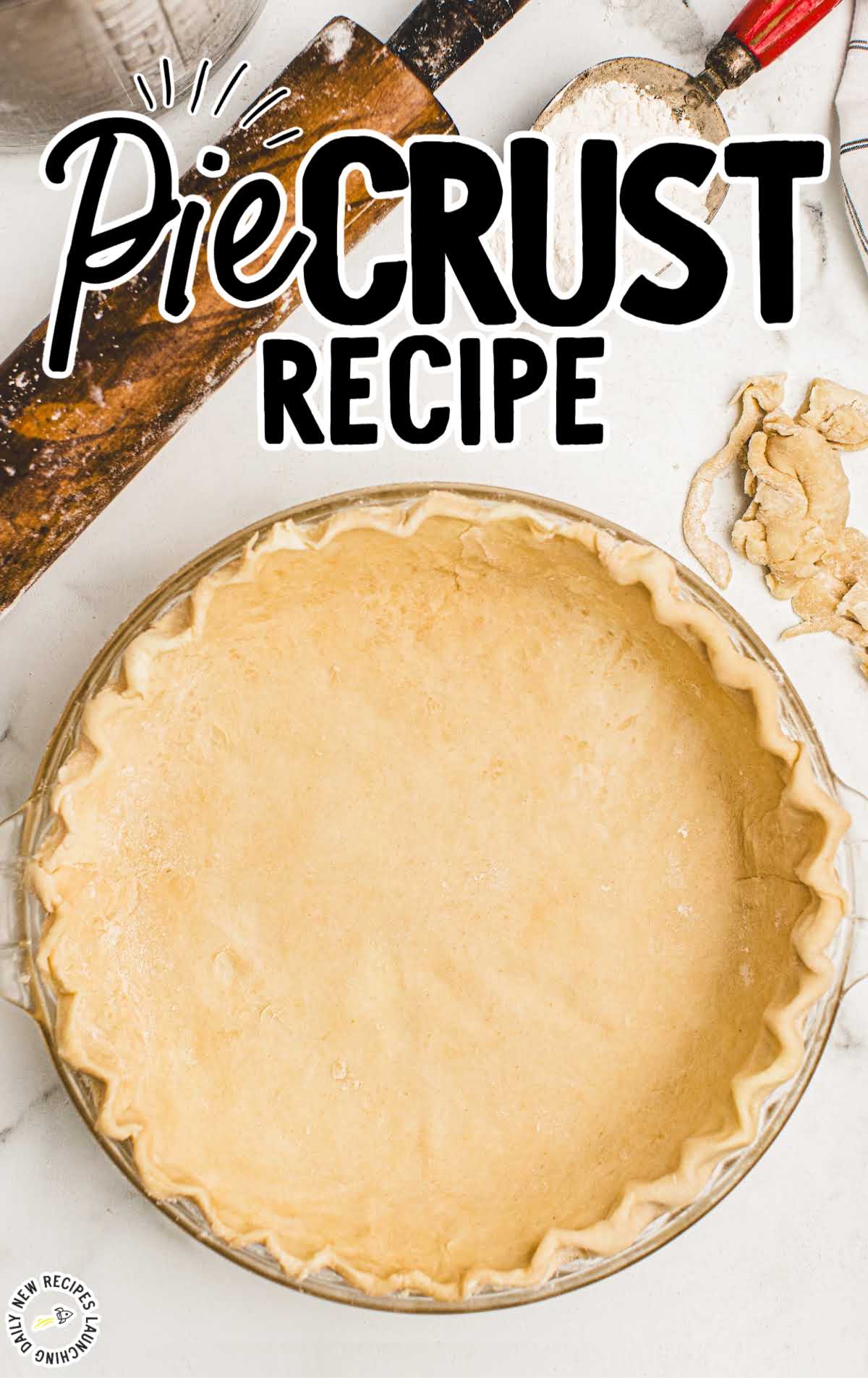
Pie Crust Ingredients
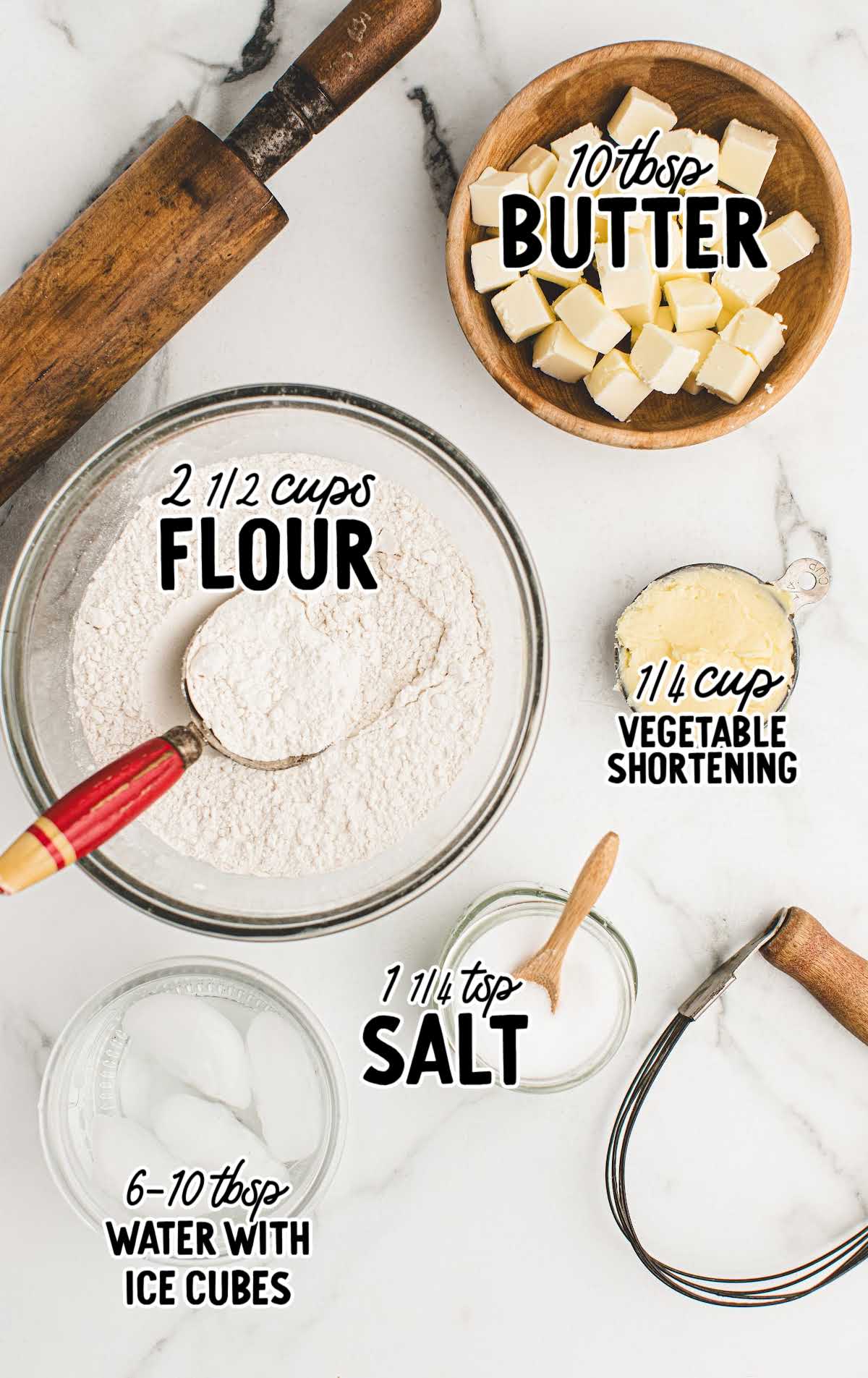
Picture a flaky, buttery texture that is both melt-in-your-mouth and satisfyingly crunchy.
Whether it’s a sweet fruit filling or a savory pot pie, this delicious crust serves as the foundation for the entire pie.
You’ll need:
- 2½ cups of all-purpose flour
- 1¼ teaspoons of salt
- ¼ cup of vegetable shortening, butter flavored
- 10 tablespoons of very cold unsalted butter
- 6 to 10 tablespoons of water, with ice cubes in it
Substitutions And Additions
SALT: This recipe calls for unsalted butter. If you are using salted butter, we would recommend cutting back or eliminating the salt in the recipe.
How To Make This Pie Crust Recipe
Our step-by-step instructions will walk you through the process of making your own pie crust at home.
STEP ONE: Measure your flour by gently spooning it into a measuring cup and then sweeping off any excess, using the back of a butter knife.
Add the measured flour and salt to a medium mixing bowl.
Whisk together to combine. Add the shortening, working it into the flour until the mixture is crumbly. It should resemble coarse sand and thoroughly combine.
OUR RECIPE DEVELOPER SAYS
This is where using a pastry cutter works wonders.
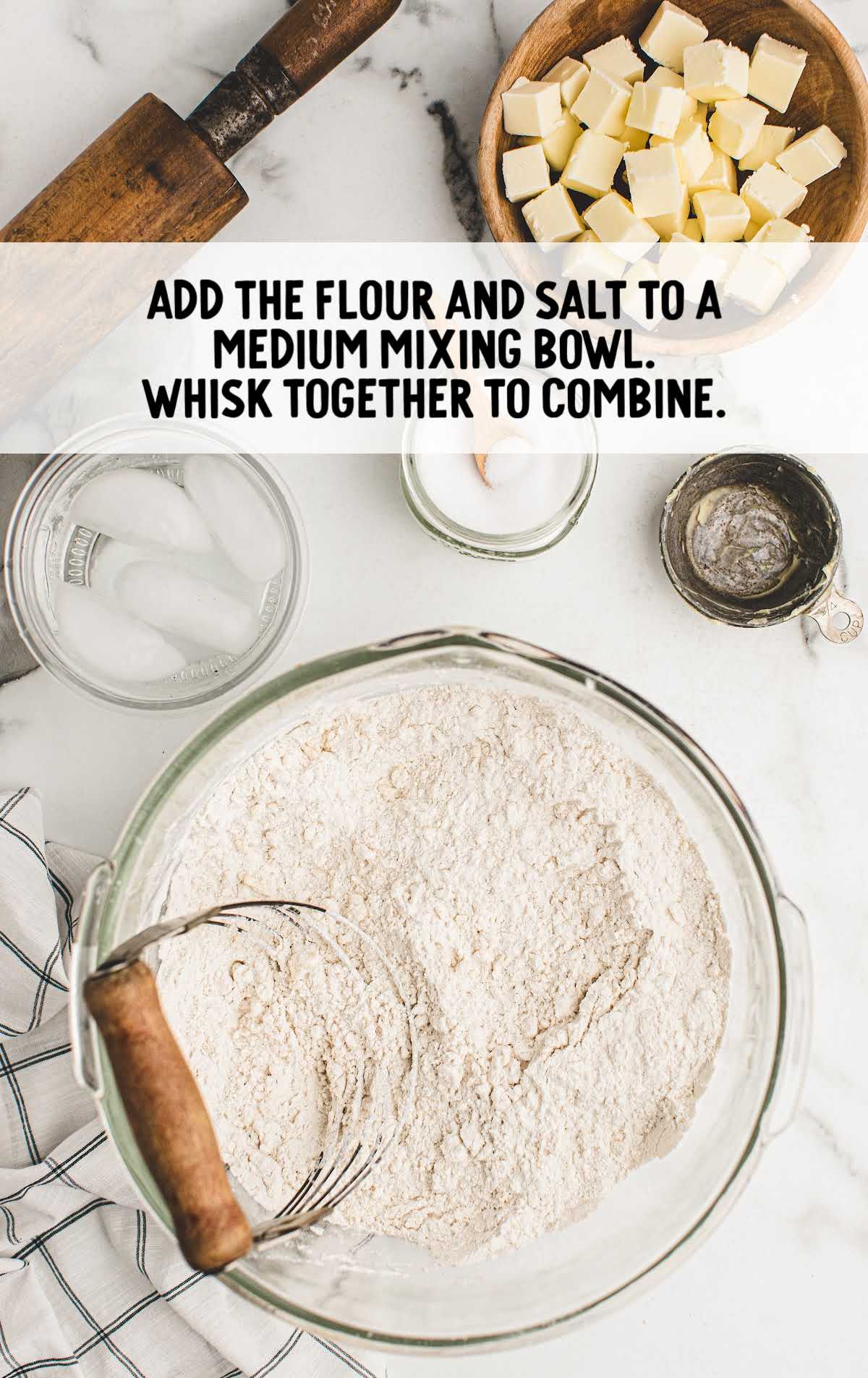
STEP TWO: Cut the cold butter into small cubes, cutting each tablespoon into four pieces.
Add the butter to the flour mixture and quickly work it into the mix with a pastry blender.
You can also use your hands to crumble the butter pieces in with the flour.
The mixture should be somewhat uneven, with bigger chunks of butter mixed in with the smaller pieces.
PRO TIP:
Bits of butter help your crust come out more flaky and delicious, so it’s okay to have some chunks throughout the mix.
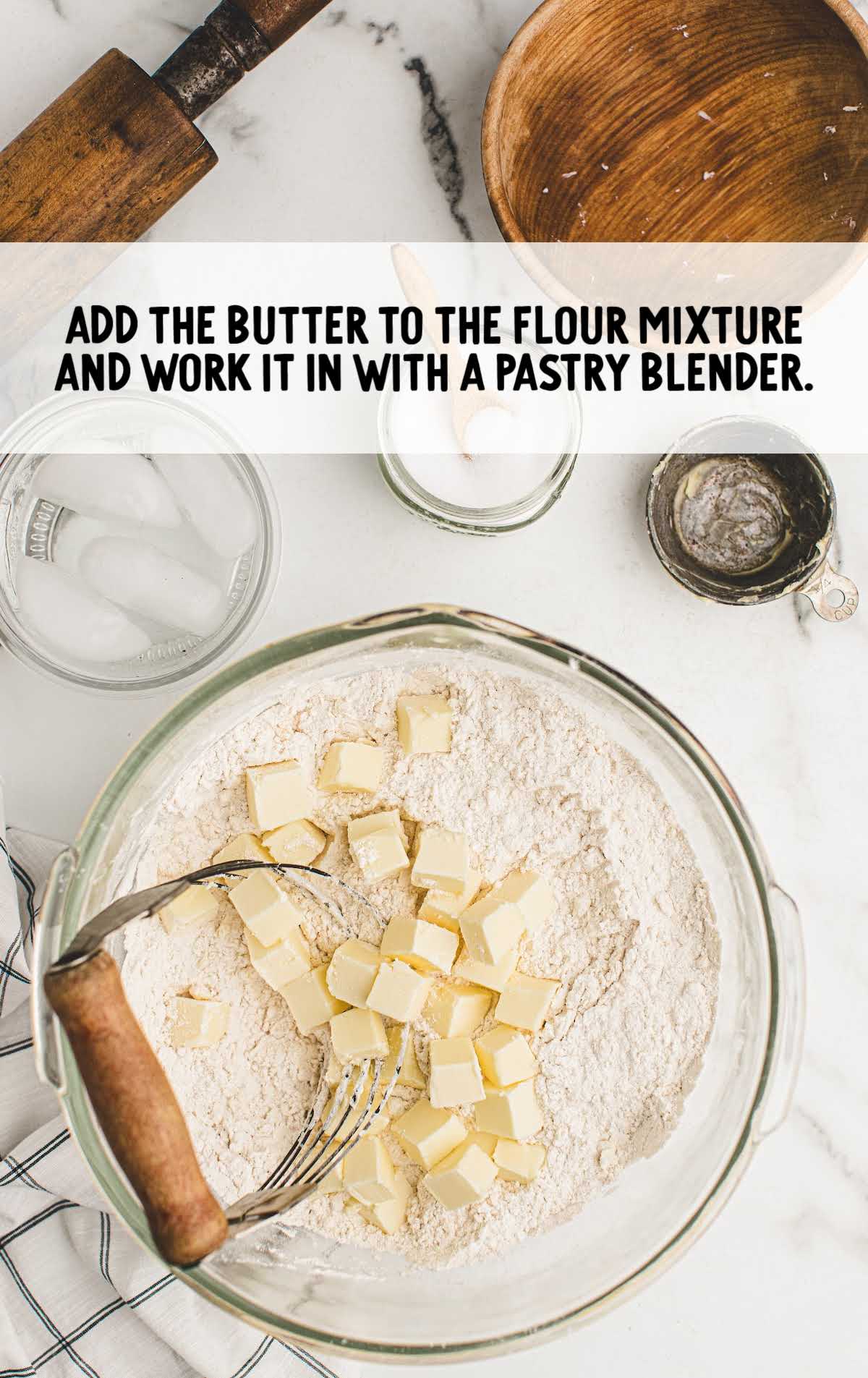
STEP THREE: Drizzle four tablespoons of ice water over the mixture. Toss gently to combine.
Add only enough additional tablespoons of water to make it hold together when you gather it up and squeeze it in your hand.
You don’t want to knead your dough or add too much water, as this will create a tougher crust.
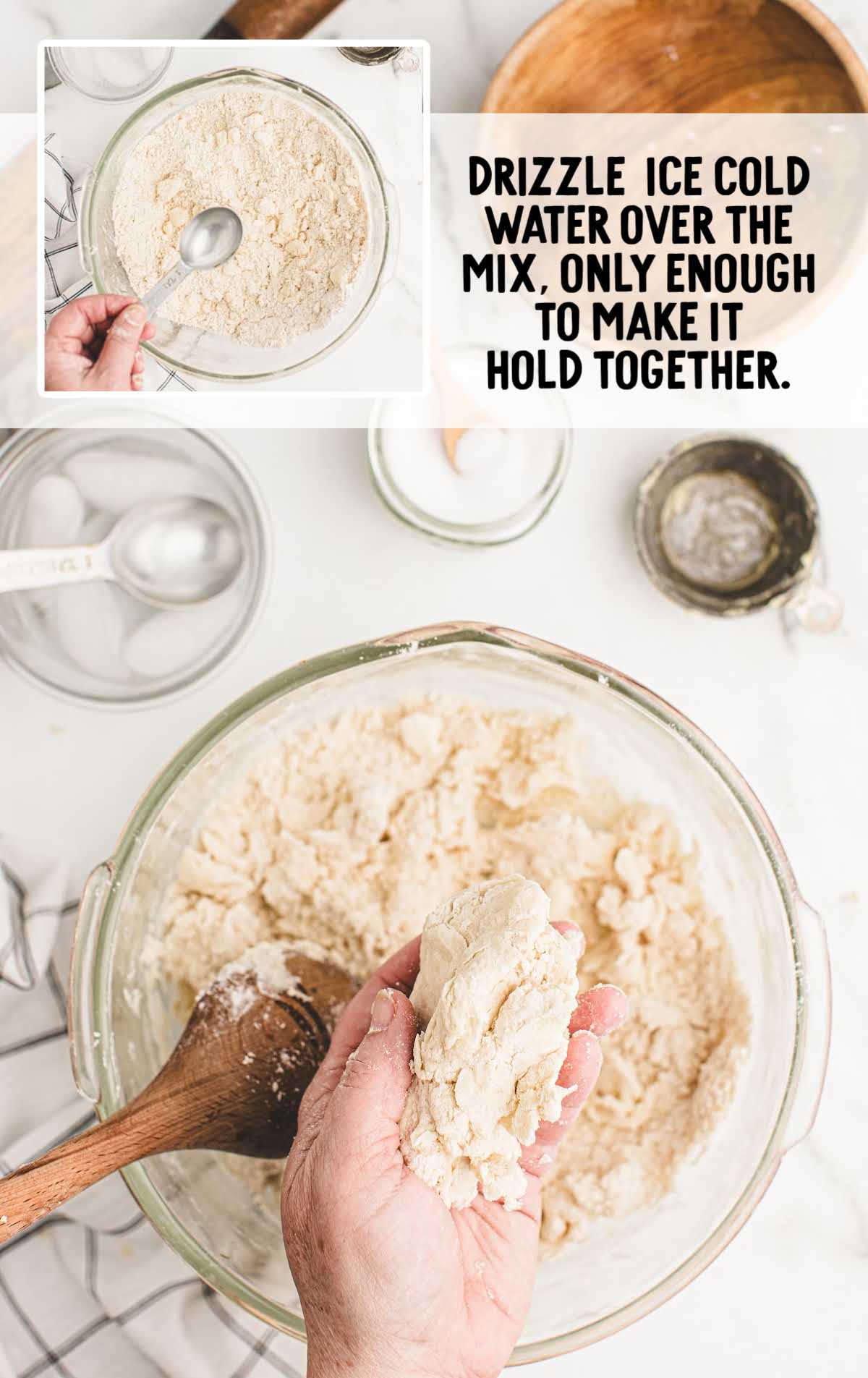
STEP FOUR: Transfer the mixture to a piece of parchment paper. Fold the dough into a rectangle, and then fold the dough into thirds.
Roughly shape it into a rectangle about 7×15. Then fold the right side to the middle about one-third, then fold the left side to the middle.
Flatten back out into a rectangle again and repeat. It should resemble a business letter in shape. If needed, spray a little bit of cold water on any dry areas.
Flatten and fold again, repeating this process until it has been incorporated. Folding the dough this way will create more flaky layers in your crust.
PRO TIP:
Make sure not to handle the dough too much with your hands as they will heat up the dough and melt the butter.
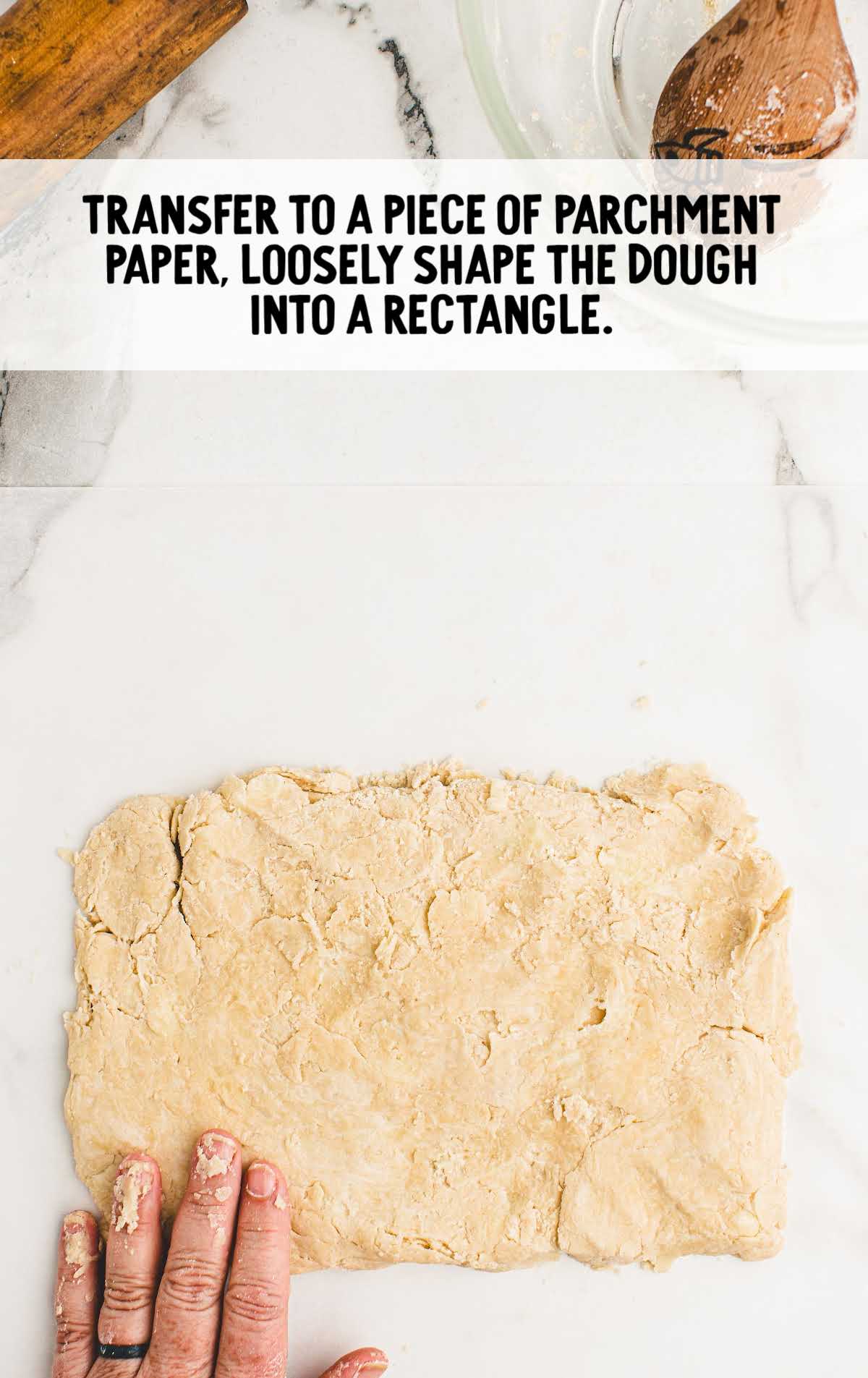
STEP FIVE: Divide the dough in half. Shape each piece of dough into a round disk.
Roll the edges of the round disk along a lightly floured cutting board to smooth out the sides, kind of like rolling a wheel.
The smoother you can get your edges now, the smoother and more round your pie crust will be when it is rolled out.
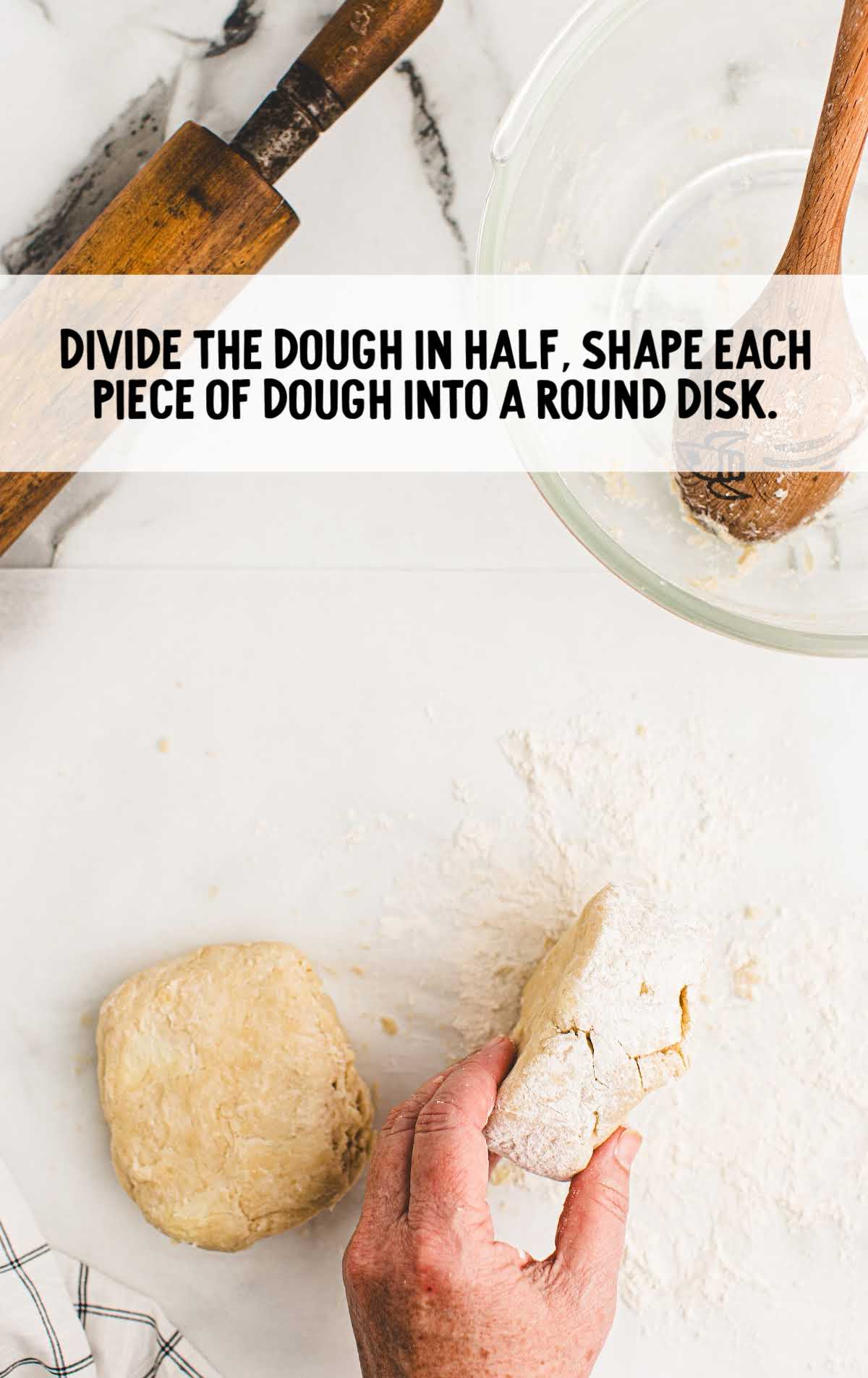
STEP SIX: Wrap the dough in plastic wrap and refrigerate it for at least 30 minutes or the dough can also be refrigerated overnight.
To Make Your Pie
PRO TIP:
If you want to make a double-crust pie, we have included directions below this section to help you out!
STEP ONE: When the pie crust dough is done refrigerating, remove it from the refrigerator.
Allow it to warm just a bit if chilled longer than 30 minutes (a few minutes will do).
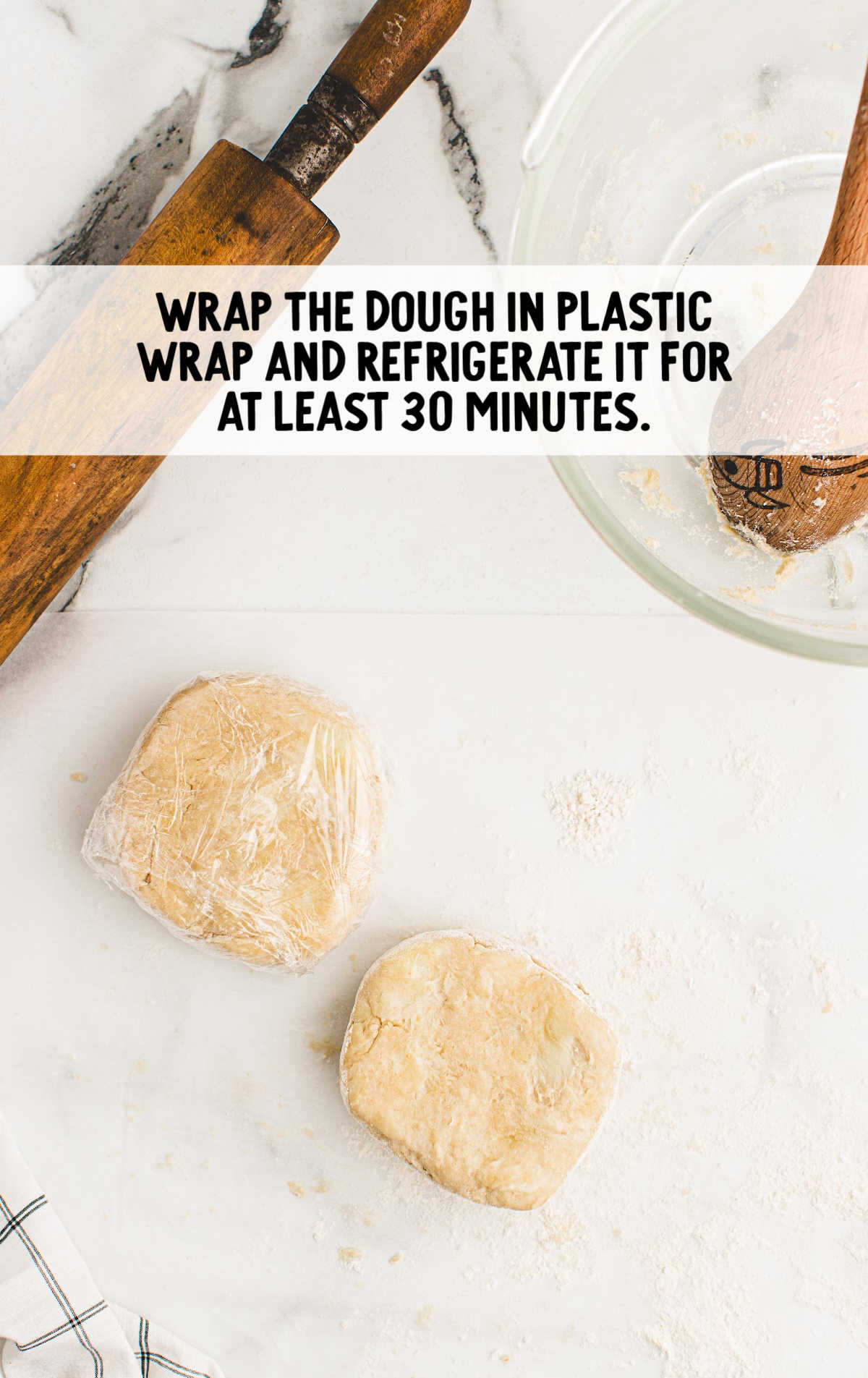
STEP TWO: When it is soft enough to roll, place the dough crust on a lightly floured work surface.
Roll dough from the center outward using a rolling pin, one piece at a time. It should roll out to be about 13 inches round.
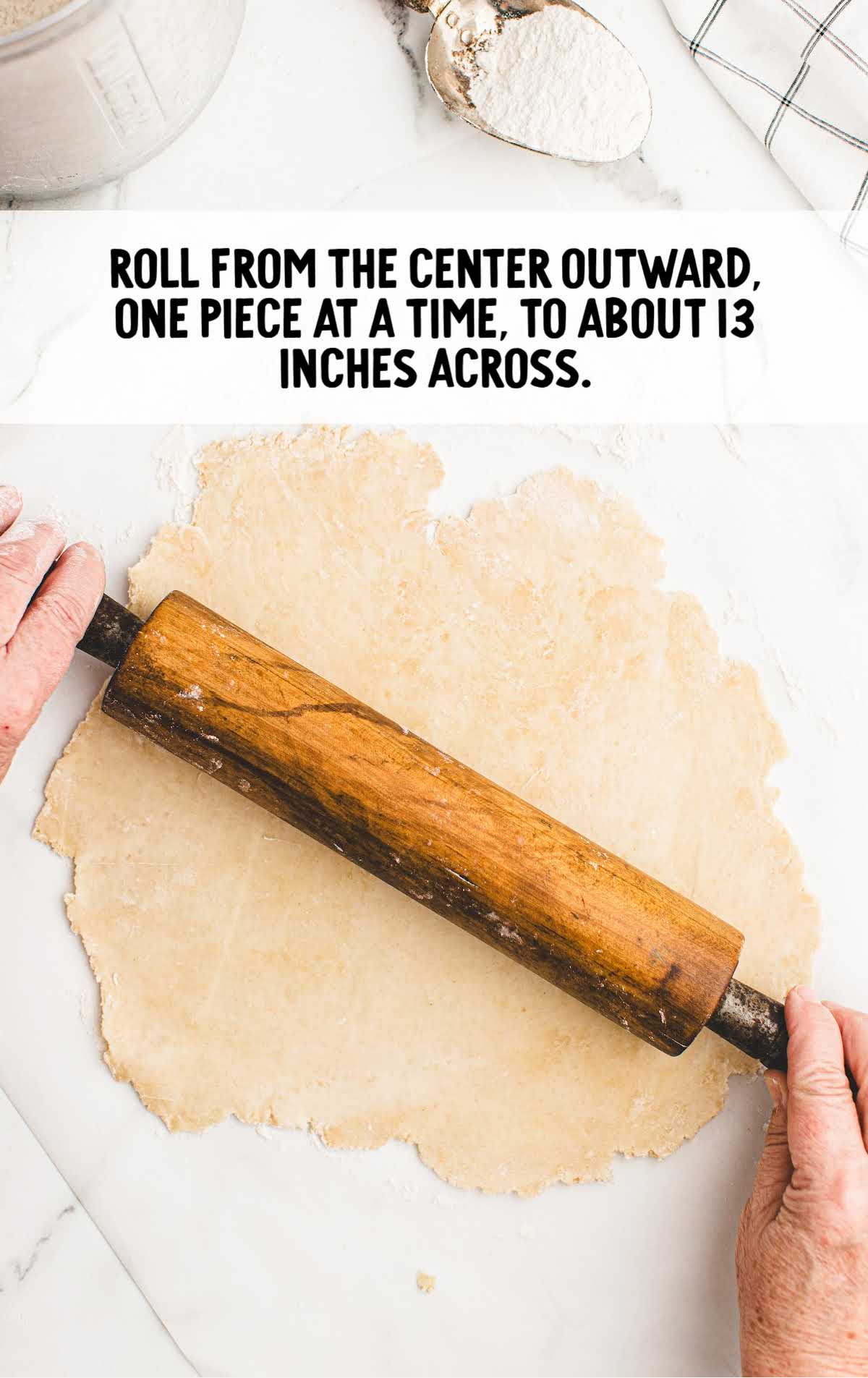
STEP THREE: You can take your pie pan, lay it on the dough, and cut two to three inches outside of it with a pizza cutter to get the perfect circle.
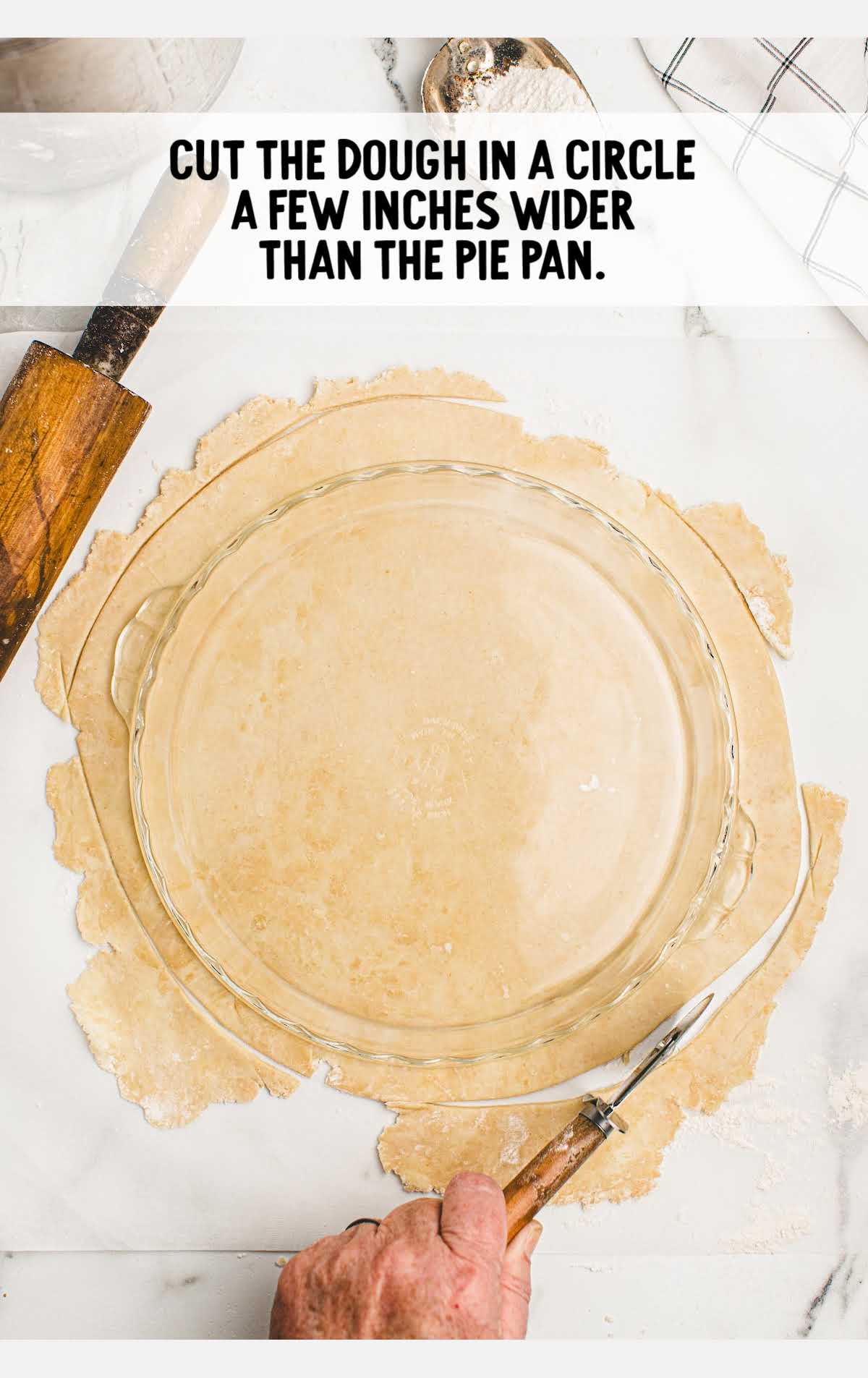
Then fold it in half and in half again to transfer to the prepared pie pan.
If the crust cracks, gently push it back together, dipping your finger in a little water to smooth it out.
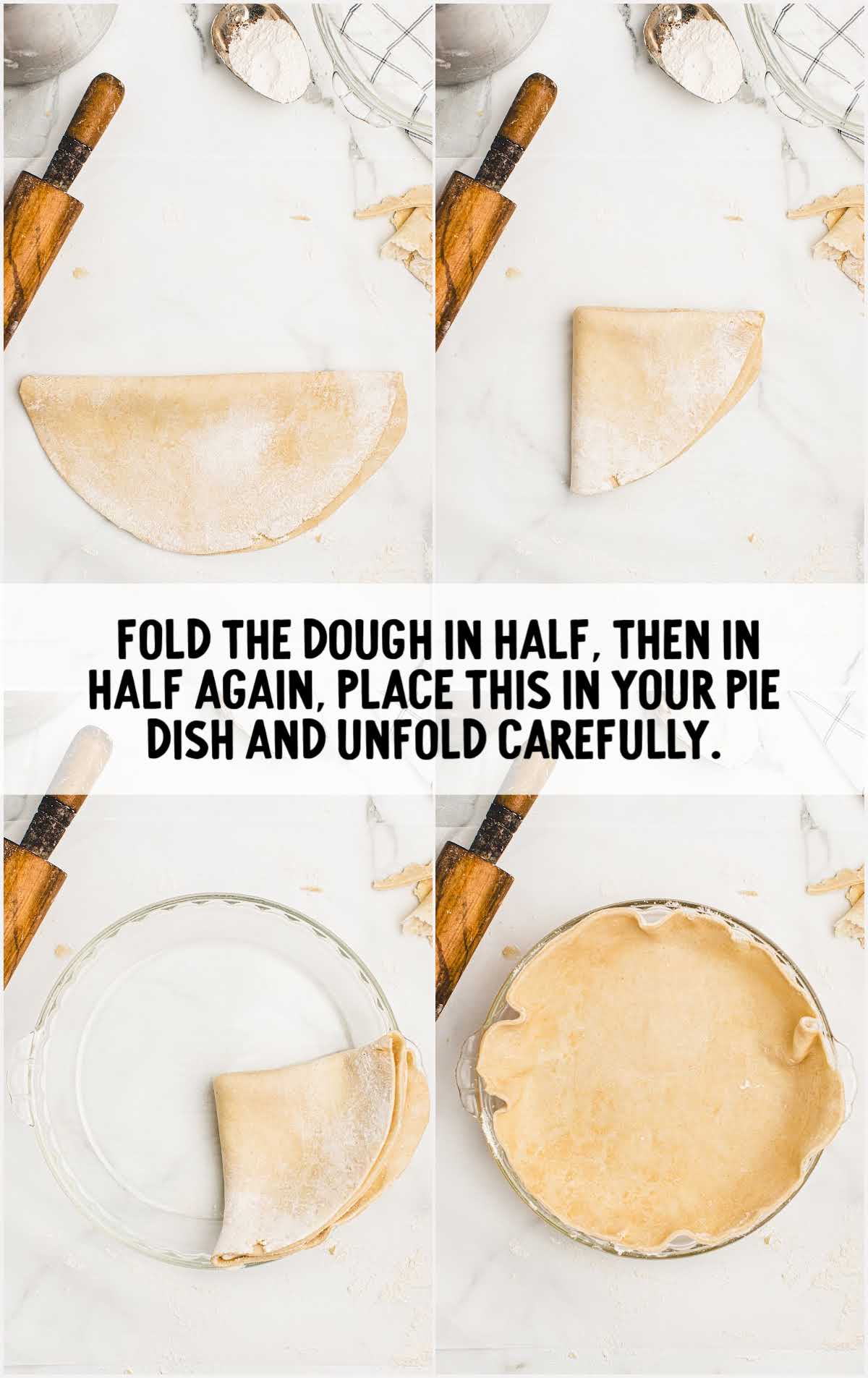
STEP FOUR: Lightly grease your pie dish with cooking spray. Gently transfer your rolled-out pie crust to the dish.
Add canned pie filling right away, or if making a filling, tent the pie crust and place it in the fridge until ready to fill.
PRO TIP:
For pies that the filling isn’t to be baked, lemon meringue, etc. Prebake the pie crust.
STEP FIVE: Roll sides under or crimp the edges of the pie crust into the desired shape.
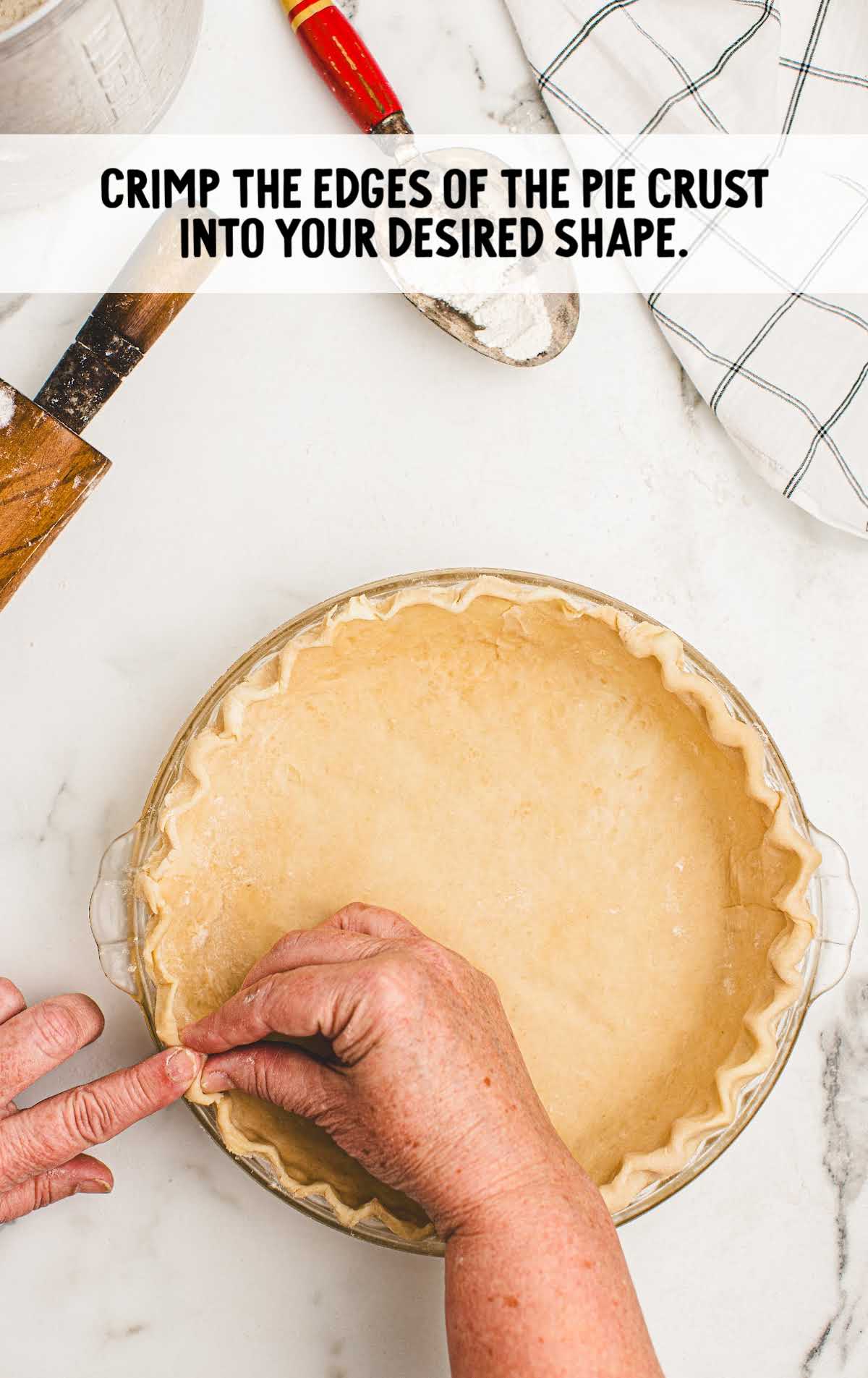
STEP SIX: Place a baking sheet in the oven and preheat to 425°F.
Remove the baking sheet when the oven comes to temperature and place the pie dish directly on the baking sheet.
Place the baking sheet in the oven on the lowest rack.
Bake the pie at 425°F for 20 minutes. Lower the temperature to 350°F and bake for an additional 60 minutes, or until the filling is bubbly and the crust is golden brown.
Check the pie when it has about 10 to 15 minutes left. If it’s already browned, then tent it with foil and allow it to cook for the remaining time.
PRO TIP:
If the edges of your crust are browning too quickly, use strips of foil wrapped around the edges, or use pie shields while baking.
STEP SEVEN: Cool the pie to allow the filling to set up.
If you want the pie to slice cleanly without oozing the filling everywhere, allow it to cool completely before serving. The pie will take a few hours to cool completely.
For A Double Pie Crust
STEP ONE: Gently transfer your rolled-out bottom crust to the dish.
Add canned pie filling right away, or if making a filling, tent the pie crust and place it in the fridge until ready to fill.
STEP TWO: Once the pie filling has been added, fold the edges under themselves. This will ensure you have a nice thick crust that will stand up when serving.
STEP THREE: Repeat the steps and roll out the remaining dough for your top crust.
STEP FOUR: Place the top crust over the pie filling and trim the edges to ½ inch of the edge if hanging over. Roll sides under.
Crimp the edges of the pie crust into the desired shape.
Make sure to vent the top of the pie by making a series of 3 to 4-inch parallel cuts on the top of the crust.
Feel free to be as decorative as you’d like. I love the lattice look myself!
STEP FIVE: Place a baking sheet in the oven and preheat to 425°F.
Remove the baking sheet when the oven comes to temperature and place the pie dish directly on the baking sheet.
Place the baking sheet in the oven on the lowest rack.
Bake the pie at 425°F for 20 minutes. Lower the temperature to 350°F and bake for an additional 60 minutes, or until the filling is bubbly and the crust is golden brown.
Check the pie when it has about 10 to 15 minutes left. If it’s already browned, then tent it with foil and allow it to cook for the remaining time.
PRO TIP:
If the edges of your crust are browning too quickly use strips of foil wrapped around the edges, or use pie shields while baking.
STEP SIX: Cool the pie to allow the filling to set up. If you want the pie to slice cleanly without oozing the filling everywhere, allow it to cool completely before serving.
The pie will take a few hours to cool completely.
How To Serve
This perfect buttery, flaky pie crust will make all your pie-making dreams come true.
No matter what filling or flavor of pie you’d like, this pie crust will be the perfect base. Try it with our French silk pie and blueberry pie.
Use this easy apple pie recipe or pumpkin pie recipe for two of our favorite pies.
Both of these homemade pies are absolutely delicious and will be made even better by using your own homemade pie crust recipe in place of a store-bought pie crust.
MORE PIE RECIPES
Storing This Easy Pie Crust Recipe
Double the ingredients and keep the extra pie crust for later, ready for delicious sweet or savory fillings.
IN THE FRIDGE: You can make this classic pie crust recipe ahead of time.
If you plan to do this, it’s best to make the dough and wrap it in plastic wrap, then place the dough in the fridge.
When you’re ready to make the pie, you can roll the dough out at that time.
IN THE FREEZER: Pie crust is a great option for the freezer.
As long as your pie crust is wrapped tightly in plastic wrap or aluminum foil, and placed into a freezer Ziploc bag, it should last for about six months in the freezer.
That way, you have a delicious homemade pie crust ready to go. Be sure to allow it to thaw before using it in your next pie recipe.
Why We Love This Recipe
BUTTERY AND FLAKY: Its tender layers practically melt in your mouth, creating the perfect foundation for both sweet and savory pies.
EASY TO MAKE: With simple ingredients and step-by-step instructions, you can confidently create a homemade pie crust with ease.
CRISP AND GOLDEN: When baked, this pie crust achieves a beautiful, crisp, and golden-brown finish that enhances the visual appeal of your pies.
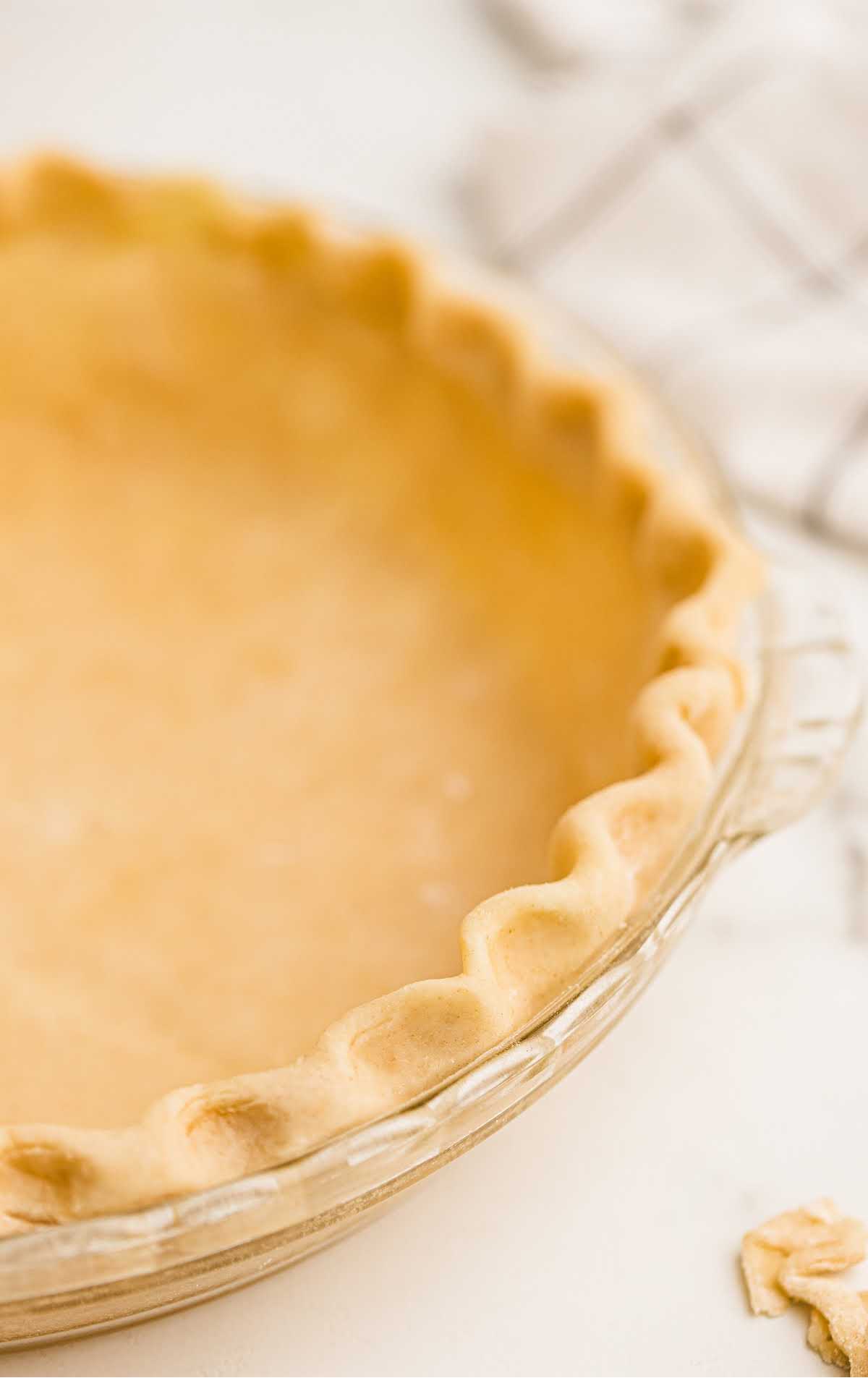
Nothing beats a homemade pie, complete with a flaky crust. This pie crust recipe is a simple and easy way to make a homemade pie crust. It’s sure to take your pies to the next level!
Frequently Asked Questions
We recommend using a glass pie plate in this easy pie crust recipe. Glass conducts heat evenly when baking, and the glass dish will also allow you to see when the sides and bottom have browned.
If you don’t use enough water when preparing the dough, your pie crust will end up crumbly.
A tough crust results from there not having enough fat (butter or shortening) in your dough. Overworking the dough can also result in tough crusts.
Ensuring the butter is cold when blended into the crust helps prevent it from melting, and if the butter melts before baking, you will lose that flakiness that we all love so much in pie crusts.
More Recipes You’ll Love
- Chocolate Chip Pie
- Pistachio Pie
- Chocolate Pie with Meringue Recipe
- Mississippi Mud Pie
- Chocolate Cherry Pie

Pie Crust
Ingredients
- 2½ cups all-purpose flour
- 1¼ teaspoons salt
- ¼ cup vegetable shortening, butter flavored
- 10 tablespoons unsalted butter, very cold
- 6 to 10 tablespoons water, with ice cubes in it
Instructions
- Measure your flour by gently spooning it into a measuring cup and then sweeping off any excess using the back of a butter knife. Add the measured flour and salt to a medium mixing bowl. Whisk together to combine. Add the shortening, working it into the flour until the mixture is crumbly using a pastry cutter. It should resemble coarse sand and be thoroughly combined.
- Cut the butter into small cubes (cut each tablespoon into 4 pieces). Add the butter to the flour mixture and toss to cover the pieces with flour. Quickly work it into the mix with a pastry cutter or your hands breaking apart the pieces of butter and continuing to toss in the flour. The mixture should be somewhat uneven, with bigger chunks of butter mixed in with the smaller pieces (bits of butter help your crust come out more flaky and delicious, so it’s okay to have some chunks throughout the mix).
- Drizzle 4 tablespoons of ice cold water over the mixture (I ended up using 8 tablespoons). Toss gently to combine. Add only enough additional tablespoon of water to make it hold together when you gather it up and squeeze it in your hand (you don’t want to knead your dough or add too much water as this will create a tougher crust).
- Transfer the mixture to a piece of parchment paper. Loosely shape the dough into a rectangle about 15×7 or so. Fold the right side toward the middle for about one-third. Then fold the left side toward the middle. It should resemble a business letter in shape. If needed, spray a little bit of cold water on any dry areas. Flatten and fold again, repeating this process until it has been incorporated. (folding the dough in this way will create more flaky layers in your crust). Make sure not to handle the dough too much with your hands as they will heat up the dough and melt the butter.
- Divide the dough in half. Shape each piece of dough into a round disk. Roll the edges of the round disk along a lightly floured cutting board to smooth out the sides, kind of like rolling a wheel. The smoother you can get your edges now, the smoother and more round your pie crust will be when it is rolled out.
- Wrap the dough in plastic wrap and refrigerate it for at least 30 minutes (this dough can be refrigerated overnight).
- When the dough is done refrigerating, remove it from the refrigerator. Allow it to warm just a bit if chilled longer than 30 minutes (a few minutes will do). When it is soft enough to roll, place the dough crust on a lightly floured surface. (I used lightly floured parchment paper that I turned after a few rolls, I put the corner of the parchment paper between my leg and the counter to keep it from moving.) Roll from the center outward, one piece at a time. It should roll out to be about 13 inches round. If the crust cracks, gently push it back together, dipping your finger in water to smooth it out.
- Lay your pie pan upside down on the dough to see if it is rolled out enough for the pan. Using a pizza cutter or knife, cut the dough in a circle a few inches away from the pie pan. Discard the dough or cut cute little shapes to bake on the pie or separate.
- Lightly grease your pie dish with cooking spray.
- You now have a big circle of dough. Fold the dough in half to make a half circle, then in half again. Place this in your prepared pie dish.
- If making a single crust pie that has a filling that needs to bake like pumpkin or custard then using a sharp knife “dot” the bottom of the crust in a few spots, not slits but just tiny holes. Fill with your filling and bake per pie instructions.
Notes
- For pies that the filling isn’t to be baked, lemon meringue, etc. Prebake the pie crust.
- For two-crust pies, start here. Gently transfer your rolled-out pie crust to the dish. Add canned pie filling right away, or if making a filling, tent the pie crust and place it in the fridge until ready to fill.
- Once the pie filling has been added, fold the edges under themselves. This will ensure you have a nice thick crust that will stand up when serving.
- Repeat the steps and roll out the remaining dough for your top crust.
- Place the top crust over the pie filling and trim the edges to ½ inch of the edge if hanging over. Roll sides under. Crimp the edges of the pie crust into the desired shape. Make sure to vent the top of the pie by making a series of 3” to 4” parallel cuts on the top of the crust. Feel free to be as decorative as you’d like. I love the lattice look myself!
- Place a baking sheet in the oven and preheat to 425°F. Remove the baking sheet when the oven comes to temperature and place the pie dish directly on the baking sheet. Place the baking sheet in the oven on the lowest rack. Bake the pie at 425°F for 20 minutes. Lower the temperature to 350°F and bake for an additional 60 minutes, or until the filling is bubbly and the crust is golden brown. Check the pie when it has about 10-15 minutes left. If it’s already browned, then tent it with foil and allow it to cook for the remaining time.
- Cool the pie to allow the filling to set up. If you want the pie to slice cleanly without oozing the filling everywhere, allow it to cool completely before serving. The pie will take a few hours to cool completely.
- If the edges of your crust are browning too quickly, use strips of foil wrapped around the edges, or use pie shields while baking.
- Bits of butter help your crust come out more flaky and delicious, so it’s okay to have some chunks throughout the mix.
- Make sure not to handle the dough too much with your hands as they will heat up the dough and melt the butter.
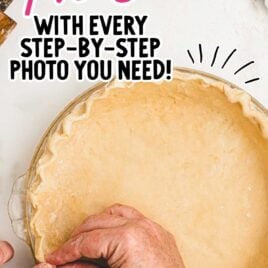
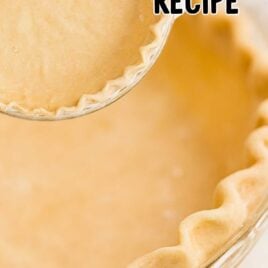
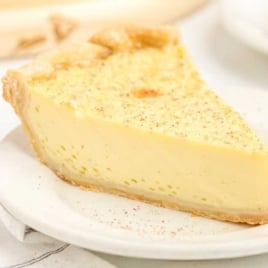
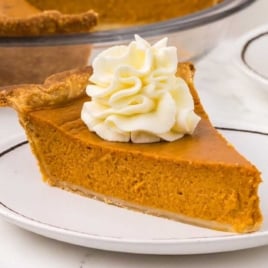
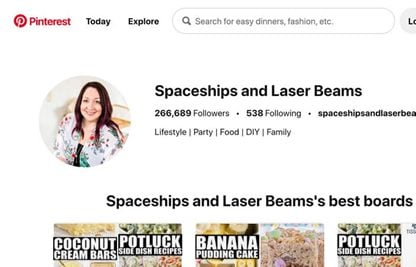





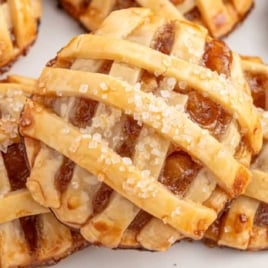
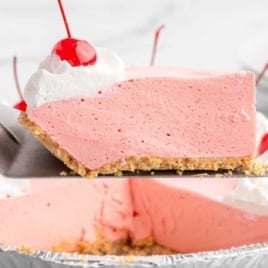
Comments
jay platte says
i made this with an apple pie, it was so delicious! will definitely have to make them again!
Gloria says
This is a classic recipe that everyone should have in their arsenal.
Gloria says
Can’t wait to try making this 😍